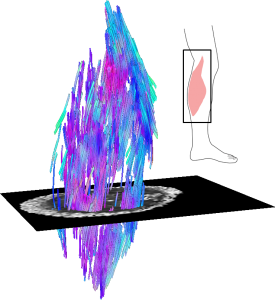https://blog.neura.edu.au/2016/09/muscle-contracture-after-stroke/#sthash.G6k2GnGc.dpbs
Cutting-edge imaging technologies are being used to understand what causes muscle contracture after a stroke and how we can improve treatments.

Example of a 3D reconstruction of the muscle fibre
structure of a human calf muscle (medial gastrocnemius) using diffusion tensor
imaging.
We believe a lot of fundamental questions about muscles have yet to be
answered, but that may be about to change with the use of diffusion tensor
imaging (DTI).DTI is an MRI-based imaging technique typically used to measure white matter in the brain. Recent advancements in imaging technology have allowed researchers, like ourselves, to more accurately measure muscle fibres as well.
A recent study we conducted revealed that DTI produces more reliable images and minimises the effect of errors typically found in ultrasound images. This is because muscles have complex 3D shapes, so 3D methods such as DTI have many advantages over the more conventional 2D techniques like ultrasound imaging.
We’ll put this information to good use in a new clinical trial aimed at understanding the cause of muscle contracture (stiffening of muscles) in stroke. Contracture is a common cause of disability in people who have had a stroke and, at present, the mechanisms that cause contracture are poorly understood. Additionally, current intervention strategies to treat contracture have been shown to be ineffective. Clearly, there is a need to improve our current understanding of contracture so that it can be treated effectively.
We are seeking volunteers to participate in the study. Participants could be people of any age who have had a stroke and have some physical disability, or healthy people aged over 60. Participation in the study involves coming to NeuRA and having an MRI scan. The visit, including the scan, takes around two hours.
If you are interested in finding out more about the study, please call NeuRA on 02 9399 1832 and ask to speak with Arkiev D’Souza, or send an email to a.dsouza@neura.edu.au with your enquiry.
Cutting-edge
imaging technologies are being used to understand what causes muscle
contracture after a stroke and how we can improve treatments.
 We believe a lot of fundamental questions about muscles have yet to
be answered, but that may be about to change with the use of diffusion
tensor imaging (DTI).
We believe a lot of fundamental questions about muscles have yet to
be answered, but that may be about to change with the use of diffusion
tensor imaging (DTI).
DTI is an MRI-based imaging technique typically used to measure white matter in the brain. Recent advancements in imaging technology have allowed researchers, like ourselves, to more accurately measure muscle fibres as well.
A recent study we conducted revealed that DTI produces more reliable images and minimises the effect of errors typically found in ultrasound images. This is because muscles have complex 3D shapes, so 3D methods such as DTI have many advantages over the more conventional 2D techniques like ultrasound imaging.
We’ll put this information to good use in a new clinical trial aimed at understanding the cause of muscle contracture (stiffening of muscles) in stroke. Contracture is a common cause of disability in people who have had a stroke and, at present, the mechanisms that cause contracture are poorly understood. Additionally, current intervention strategies to treat contracture have been shown to be ineffective. Clearly, there is a need to improve our current understanding of contracture so that it can be treated effectively.
We are seeking volunteers to participate in the study. Participants could be people of any age who have had a stroke and have some physical disability, or healthy people aged over 60. Participation in the study involves coming to NeuRA and having an MRI scan. The visit, including the scan, takes around two hours.
If you are interested in finding out more about the study, please call NeuRA on 02 9399 1832 and ask to speak with Arkiev D’Souza, or send an email to a.dsouza@neura.edu.au with your enquiry.
- See more at: https://blog.neura.edu.au/2016/09/muscle-contracture-after-stroke/#sthash.G6k2GnGc.dpuf

Example
of a 3D reconstruction of the muscle fibre structure of a human calf
muscle (medial gastrocnemius) using diffusion tensor imaging.
DTI is an MRI-based imaging technique typically used to measure white matter in the brain. Recent advancements in imaging technology have allowed researchers, like ourselves, to more accurately measure muscle fibres as well.
A recent study we conducted revealed that DTI produces more reliable images and minimises the effect of errors typically found in ultrasound images. This is because muscles have complex 3D shapes, so 3D methods such as DTI have many advantages over the more conventional 2D techniques like ultrasound imaging.
We’ll put this information to good use in a new clinical trial aimed at understanding the cause of muscle contracture (stiffening of muscles) in stroke. Contracture is a common cause of disability in people who have had a stroke and, at present, the mechanisms that cause contracture are poorly understood. Additionally, current intervention strategies to treat contracture have been shown to be ineffective. Clearly, there is a need to improve our current understanding of contracture so that it can be treated effectively.
We are seeking volunteers to participate in the study. Participants could be people of any age who have had a stroke and have some physical disability, or healthy people aged over 60. Participation in the study involves coming to NeuRA and having an MRI scan. The visit, including the scan, takes around two hours.
If you are interested in finding out more about the study, please call NeuRA on 02 9399 1832 and ask to speak with Arkiev D’Souza, or send an email to a.dsouza@neura.edu.au with your enquiry.
- See more at: https://blog.neura.edu.au/2016/09/muscle-contracture-after-stroke/#sthash.G6k2GnGc.dpuf
No comments:
Post a Comment